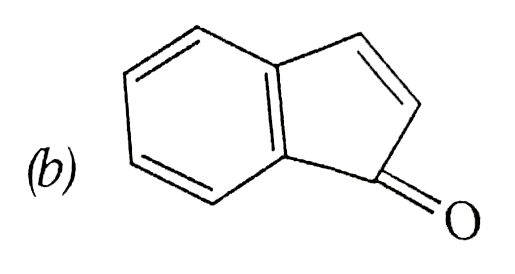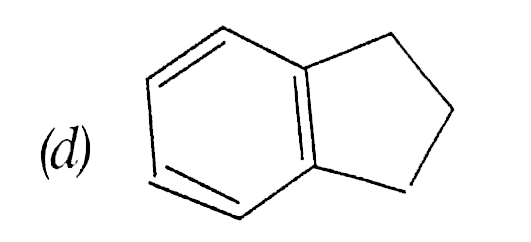Treatment of benzene with CO/HCl in the presence of anhydrous AlCl3/CuCl followed by reaction with Ac2O/NaOAc gives a compound X. Reaction of X with H2/Pd/c followed by treatment with H3PO4 gives another compound Y. The compound Y is :




The correct Answer is:A
To solve the problem step by step, let's analyze the reactions and transformations involved in the synthesis of compound Y from benzene.
Step 1: Friedel-Crafts Acylation
- Reaction: Benzene reacts with carbon monoxide (CO) and hydrochloric acid (HCl) in the presence of anhydrous AlCl₃/CuCl.
- Mechanism: This reaction leads to the formation of benzaldehyde (C₆H₅CHO) through the generation of an acylium ion (C₆H₅C^+=O) which then reacts with benzene.
Result: The product formed in this step is benzaldehyde (C₆H₅CHO).
Step 2: Reaction with Acetic Anhydride
- Reaction: Benzaldehyde (C₆H₅CHO) is then treated with acetic anhydride (Ac₂O) in the presence of sodium acetate (NaOAc).
- Mechanism: This reaction leads to the formation of an aromatic ketone, specifically, the product is acetophenone (C₆H₅COCH₃).
Result: The compound X formed in this step is acetophenone (C₆H₅COCH₃).
Step 3: Hydrogenation of Compound X
- Reaction: Acetophenone (C₆H₅COCH₃) is then subjected to hydrogenation using hydrogen gas (H₂) in the presence of palladium on carbon (Pd/C).
- Mechanism: This reaction reduces the carbonyl group (C=O) of acetophenone to a secondary alcohol, yielding 1-phenylethanol (C₆H₅CH(OH)CH₃).
Result: The compound formed after this step is 1-phenylethanol (C₆H₅CH(OH)CH₃).
Step 4: Dehydration of Alcohol
- Reaction: The resulting alcohol (1-phenylethanol) is then treated with phosphoric acid (H₃PO₄).
- Mechanism: This reaction leads to the dehydration of the alcohol, resulting in the formation of an alkene, specifically styrene (C₆H₅CH=CH₂).
Result: The final compound Y formed is styrene (C₆H₅CH=CH₂).
Final Answer
The compound Y is styrene (C₆H₅CH=CH₂).
---
- Reaction: Benzene reacts with carbon monoxide (CO) and hydrochloric acid (HCl) in the presence of anhydrous AlCl₃/CuCl.
- Mechanism: This reaction leads to the formation of benzaldehyde (C₆H₅CHO) through the generation of an acylium ion (C₆H₅C^+=O) which then reacts with benzene.
Result: The product formed in this step is benzaldehyde (C₆H₅CHO).
- Reaction: Benzaldehyde (C₆H₅CHO) is then treated with acetic anhydride (Ac₂O) in the presence of sodium acetate (NaOAc).
- Mechanism: This reaction leads to the formation of an aromatic ketone, specifically, the product is acetophenone (C₆H₅COCH₃).
Result: The compound X formed in this step is acetophenone (C₆H₅COCH₃).
- Reaction: Acetophenone (C₆H₅COCH₃) is then subjected to hydrogenation using hydrogen gas (H₂) in the presence of palladium on carbon (Pd/C).
- Mechanism: This reaction reduces the carbonyl group (C=O) of acetophenone to a secondary alcohol, yielding 1-phenylethanol (C₆H₅CH(OH)CH₃).
Result: The compound formed after this step is 1-phenylethanol (C₆H₅CH(OH)CH₃).
- Reaction: The resulting alcohol (1-phenylethanol) is then treated with phosphoric acid (H₃PO₄).
- Mechanism: This reaction leads to the dehydration of the alcohol, resulting in the formation of an alkene, specifically styrene (C₆H₅CH=CH₂).
Result: The final compound Y formed is styrene (C₆H₅CH=CH₂).
The compound Y is styrene (C₆H₅CH=CH₂).
Similar Questions
Treatment of benzene with CO/HCl in the presence of anhydrous AlCl3/CuCl followed by reaction with Ac2O/NaOAc gives compound X as the major product. Compound X upon reaction with Br2/Na2CO3, followed by heating at 473 K with moist KOH furnishes Y as the major product. Reaction of X with H2/Pd−C, followed by H3PO4 treatment gives Z as the major product.
The compound Y is
View SolutionTreatment of benzene with CO/HCl in the presence of anhydrous AlCl3/CuCl followed by reaction with Ac2O/NaOAc gives compound X as the major product. Compound X upon reaction with Br2/Na2CO3, followed by heating at 473 K with moist KOH furnishes Y as the major product. Reaction of X with H2/Pd−C, followed by H3PO4 treatment gives Z as the major product.
The compound Z is
View Solution
Knowledge Check
Which of the following alkyne on treatment with H2 (2 mole)/Pt gives an optically inactive compound ?
A3-Methyl-1-pentyneB4-Methyl-1-hexyneC3-Methyl-1-heptyneDNone of the above
How many toluidines on reaction with NaNO2/HCl followed by H3PO2 treatment gives Toluene.
View SolutionAn organic compound (A),C8H4O3 in dry benzene in the presene of anhydorus AlCl3 gives compound (B). Compound (B) on treatment with PCl5 followed by reaction with H2/Pd(BaSO4) gives compound (C) which on reaction with hydrazine gives a cyclised compound (D),(C14H10N2) Idenyify (A),(B),(C) and (D). Explain the formation of (D) from (C).
View SolutionAn alkene (A)C16H16 on ozonolysis gives only one product (B)(C8H8O). Compound (B) on reaction with NH2OH followed by reaction with H2SO4,Δ gives N - methyl benzamide the compound 'A' is -
View Solutionwhich of the following compounds on reaction with NaOH and
H2O2 gives yellow colour ?
View SolutionThe reaction of compounf P with CH3MgBr (excess) in (C2H5_(2)O followed by addition of H2O give Q the compound Q on treatment with H2SO4 at 0∘ C gives R. the reaaction of R with CH3COCl in the presence of anhydrous AlCl3 in CH2Cl2 followed by treatment with H2O "produces compound S. [Et in compound P is ethyl group]
The reaction, Q to R and R TO S, are
View SolutionA compound 'X' on ozonolysis followed by reduction gives an aldehyde, C2H4O and 2-butanone. Compound 'X' is:
View SolutionA symmetrical organic compound of C4H11N give yellow oily layer on treatment with HNO2 then find the structure of the compound.
View Solution
